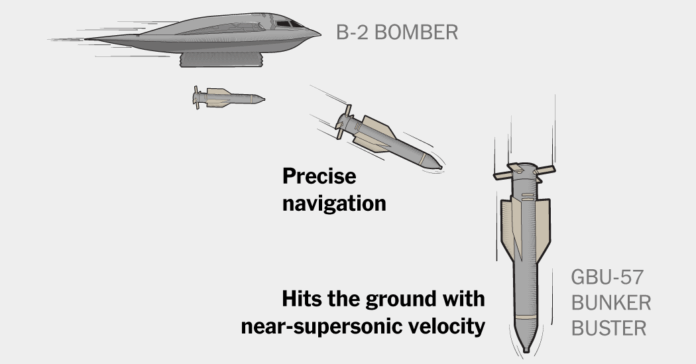Iran built its most critical nuclear enrichment facility, Fordo, deep inside a mountain to shield it from attacks.
But the United States has a bomb that experts think could probably reach the subterranean site. President Trump is considering a plan to use it.
Only the U.S. military has the 30,000-pound GBU-57, or Massive Ordnance Penetrator, that may be able to destroy Fordo, and it is the only armed force with aircraft that can carry out a mission with it.
The U.S. military has concluded that one bomb would not destroy the Fordo facility on its own. To destroy the site, an attack would have to come in waves, with bombers releasing one after another down the same hole.
Technically, military and geological experts say, it should be doable, but the mission is full of risks.
There is a lot that is not known about the facility, said Heather Williams, director of the Project on Nuclear Issues at the Center for Strategic and International Studies. “There could be some additional tunnels or facilities that are buried even more deep into the mountain,” she said.
Adding even more uncertainty, Rafael Grossi, the director general of the International Atomic Energy Agency, who has visited the facility, said last week that it was half a mile underground. But he may have been speaking in general terms, and most estimates put it 260 to 360 feet below the surface of the mountain.
The size and weight of the GBU-57 — 20 feet long and 30,000 pounds — means that only the American B-2 Spirit stealth bomber can carry it on missions. While Israel has fighter jets, it has not developed heavy bombers capable of carrying the explosive.
Fordo is located in a hilly area 60 miles south of Tehran and 15 miles away from Qom, a city of 1.4 million people. Iran built the centrifuge facility, which is critical to its uranium enrichment operations, in the 2000s knowing it needed to bury it deep to protect it from attack.
Nuclear experts have warned against any attack on nuclear facilities, but the radiation dispersal risk of striking Fordo appears to be limited.
“The uranium hexafluoride gas that is fed into the centrifuges is poisonous but is heavier than air,” said Mark Fitzpatrick, a nuclear expert at the International Institute for Strategic Studies. “Given that Fordo is below ground, any gas that escaped due to a bombing raid would mostly be contained within the plant, even if it’s directly hit with bunker busters.”
In recent years, Fordo has become Iran’s main enrichment facility. “They have the most effective centrifuges there,” said Scott Roecket, a vice president at the Nuclear Threat Initiative, a nonprofit organization dedicated to reducing the spread of nuclear weapons. “And they can be arranged in different ways in order to speed up the process.”
With nuclear facilities at Natanz and Isfahan already damaged in Israeli strikes — to what extent is not entirely clear — Fordo would be the most important piece standing in Iran’s known nuclear program.
“If Iran wanted to build a nuclear weapon either in the short, medium or long term, Fordo would be the logical place to do it,” Ms. Williams said. “So if Israel wants to achieve its objectives for this operation, it really has to figure out how to eliminate Fordo.”
Recent estimates by the Institute for Science and International Security suggest that Iran could convert its current stock of 60 percent enriched uranium into weapons-grade uranium in three weeks at Fordo, enough to produce nine nuclear weapons. It is unknown, though, whether Iran has the weaponization capabilities needed to do so.
In March 2023, the International Atomic Energy Agency reported that it had discovered some uranium that had been enriched to 83.7 percent purity at Fordo — close to the 90 percent enrichment level necessary for nuclear weapons.
Experts say there are other options for trying to destroy Fordo. Israel could carry out sustained air strikes with alternative bunker busters.
“They are smaller, but given that Israel has air superiority over the region now, they could offensively conduct longer-term strikes on Fordo to try to destroy it,” Ms. Williams said.
The Israeli military could also put the Fordo plant out of operation for at least a few months by bombing the air vents, collapsing the egress tunnels and cutting off the electrical supply, Mr. Fitzpatrick said.
Another option is sabotage, which Israel has used in the past against Iran’s nuclear program.
Still, history suggests that an effort to build a nuclear weapon is rarely stopped by military force alone. The attacks on Iran’s program could make the country even more determined to pursue its quest for nuclear arms.
“I don’t believe you can completely dismantle the nuclear program through military means,” Mr. Roecker said. “I think you need to negotiate a deal, with transparency and monitoring and verification, in order to fully address a nuclear program. It is the most effective way to repurpose that facility.”


